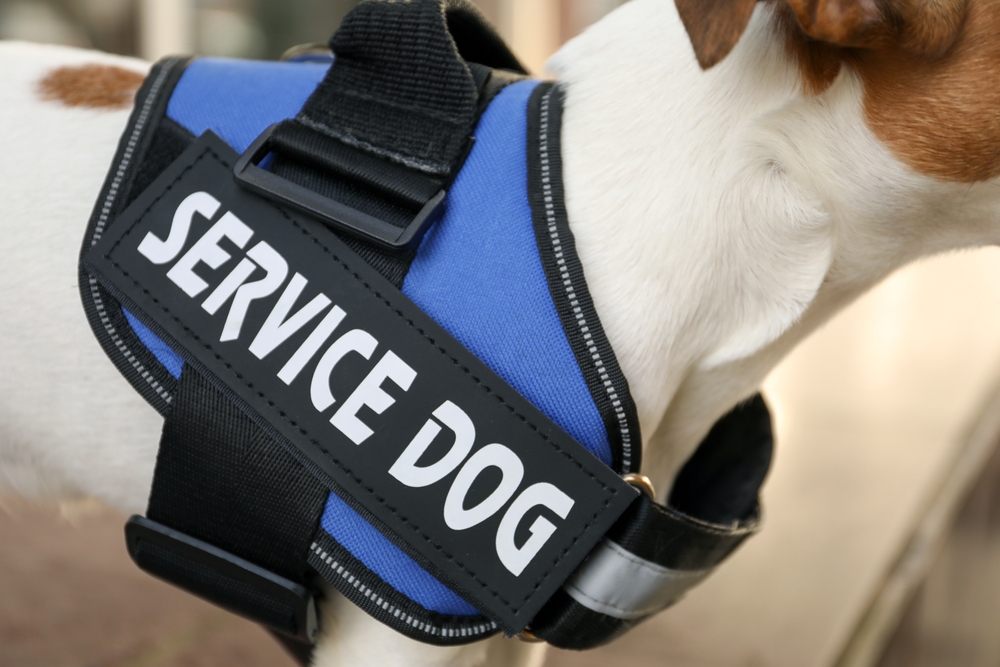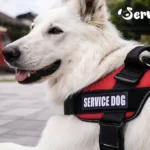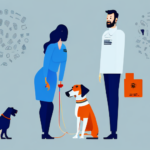A service dog vest is more than just an accessory, for a service animal and its handler it’s a vital piece of equipment that communicates a dog’s important role to the public. The purpose of a Service vest is to clearly identify a dog as a working animal, ensuring they can access public spaces with their handlers without issue. For handlers, the right gear provides support and functionality, making it an essential tool for their daily lives.
The best service dog vests, harnesses, and training gear serve specific purposes, offering features tailored to service dogs, emotional support animals (ESAs), and therapy dogs. Understanding the range of available options, their unique functions, and what to look for when selecting gear can help you choose the right vest or harness for your companion.Key features, such as comfort, durability, visibility, and ease of use, distinguish certain vests and harnesses, ensuring that both you and your dog are well-supported in any situation.
There are various types of service dog vests, each tailored to specific needs. Lightweight training vests prioritize comfort and adaptability, while heavy-duty vests offer durability and functionality for certified service dogs. Specialized options, such as reflective, tactical, and cooling vests, offer unique features including enhanced visibility, modularity, clear identification, and temperature regulation, ensuring safety and efficiency for both the dog and handler.
Why Use a Vest and Harness for a Service Dog in Training?
A service dog in its training vest and harness is a specialized garment worn by dogs that are actively learning to perform tasks and adapt to public environments, but who have not yet completed their training as certified service animals.
Training vests are specifically designed to indicate that a dog is still in training and may not yet have full public access rights. These vests will often have a label such as “In Training,” as this works to inform the public not to distract the dog. This creates a more focused environment for the dog. Training vests are typically lightweight and designed to be adjustable to keep up with the dog as it grows during the training process.
Certified service dog vests, on the other hand, are built to identify fully trained service animals with public access rights. These vests are made from durable materials and often feature additional features, such as pockets, handles for specific tasks, and clear “Service Dog” labels.
These vests are designed for long-term use and prioritize functionality to meet the handler’s particular needs. While some handlers may use the same vest throughout the dog’s training and certification, many opt for a more specialized vest once the dog is fully trained and certified. This transition not only signals the dog’s status but also ensures the gear aligns with the handler’s requirements for daily tasks.
What Is the Purpose of an Emotional Support Dog Vest?
An emotional support dog vest is used to identify the animal as an Emotional Support Animal (ESA), which helps communicate to the public the dog’s role. While the vest serves as a visual cue to inform others, it is important to note that it does not grant the animal public access rights under the Americans with Disabilities Act (ADA).
Unlike service dogs, ESAs are not trained to perform specific tasks related to a disability; therefore, they do not have the same legal protections for public access.
The vest is incredibly helpful in public, especially in settings where the presence of an ESA might cause confusion or distraction, such as in housing or travel situations where ESAs are granted specific rights under the Fair Housing Act (FHA) or the Air Carrier Access Act (ACAA). By wearing a vest, the animal’s role is immediately communicated, reducing the handler’s need to explain the ESA’s purpose repeatedly. However, handlers should be aware that the vest is not a substitute for proper documentation, as landlords or airlines may still require official paperwork to verify the ESA’s status.
How Does an Emotional Support Dog Vest Differ From a Service Dog Vest?
An emotional support dog vest differs from a service dog vest primarily in its purpose and the rights it represents. A service dog vest identifies a dog that has been specifically trained to perform tasks that mitigate a handler’s disability, granting the dog public access rights under the Americans with Disabilities Act (ADA). These vests feature sturdy handles, task-specific attachments, and clear labels, such as “Service Dog,” to communicate the dog’s working role.
However, an emotional support dog vest is designed to identify the animal as an Emotional Support Animal (ESA), which provides comfort and companionship but is not trained to perform specific tasks. While an ESA vest may help reduce public questioning or misunderstandings, it does not grant the animal public access rights under the ADA. The difference lies in the legal protections; service dogs are recognized as essential for their handler’s independence, like a wheelchair, while ESAs are primarily for emotional support and are only granted rights in specific contexts, such as housing or air travel, under laws like the Fair Housing Act (FHA) or Air Carrier Access Act (ACAA).
How Does the Right Service Dog Gear Support Training and Behavior?
If a service dog gets distracted, it can lead to very dire consequences for their handler. Service dogs are working and have a job they need to do. Having the right service dog gear sets up the service dog and its handler for success. The right service dog gear, including a service dog vest, is a part of training because it signals to the public not to distract the dog. Distractions can be anything from petting the dog to engaging with the dog by speaking to it. It reduces distractions and unnecessary interactions, allowing the handler to maintain control and create an environment conducive to practical training.
Additionally, properly fitted gear prevents chafing, discomfort, or restricted movement, which can negatively impact the dog’s behavior and willingness to work.
Handles or attachment points for leashes also give handlers better control, effectively allowing them to guide the dog and reinforce desired behaviors. This combination of clear communication, physical support, and behavioral reinforcement is essential for developing a reliable and well-trained service dog.
What are the Best Service Dog Vests Available?
Choosing the right service dog vest is essential for comfort, functionality, and clear communication of the dog’s role.
- Lightweight Mesh Vests: Designed for warm climates, they are crafted from breathable materials to keep your dog cool and comfortable during extended working hours. They are ideal for service dogs in training or those working in hot environments.
- Padded Harness-Style Vests: Built for durability and comfort, featuring padded straps and sturdy materials, making them suitable for daily use. They often include handles for mobility assistance and multiple attachment points for leashes or gear.
- Reflective Vests: Prioritizing safety, these vests feature reflective strips or bright colors to enhance visibility in low-light conditions. They are perfect for service dogs working in outdoor or high-traffic areas.
- Tactical Vests: Designed for specialized tasks, these vests include MOLLE (Modular Lightweight Load-carrying Equipment) systems for attaching gear and accessories. Service dogs commonly use them in search and rescue or law enforcement roles.
- Cooling Vests: Ideal for hot climates, they use evaporative cooling technology to regulate the dog’s body temperature. They are handy for service dogs that work outdoors for extended periods.
- Training Vests: Lightweight, adjustable, and designed for dogs in training. They often feature “In Training” patches to inform the public and reduce distractions.
Each vest type caters to specific needs, ensuring both the dog and handler have the right tools for their unique requirements.
How Do I Choose the Best Service Dog Vest for My Dog?
There are a few things to consider when choosing a service dog vest that meets your dog’s specific needs while ensuring their comfort and safety! Below, we have listed a few things to take into consideration when picking out your pup’s service vest.
- Dog’s Size and Fit: You want to make sure the vest fits your dog correctly. A well-fitted vest should be snug but not restrictive, allowing for a full range of motion without causing discomfort or chafing. You wouldn’t want to wear a jacket that restricts you, so your dog wouldn’t either!
- Climate and Environment: Consider the climate your dog will be working in. If you live in a warmer climate, then lightweight mesh vests are ideal. If you live in a colder climate, then padded or insulated vests are better suited for more frigid environments.
- Type of Work: Match the vest to the tasks your dog performs. For example, a vest with handles and attachment points is ideal for mobility assistance. In contrast, a tactical vest with gear attachments is better suited for specialized tasks such as search and rescue.
- Comfort and Durability: Opt for vests crafted from high-quality, breathable materials that are both comfortable and durable enough for daily use. Features like padded straps and adjustable buckles enhance comfort and ensure a secure fit.
- Visibility and Safety: If your dog works in low-light or high-traffic areas, choose a vest with reflective strips or bright colors to enhance visibility and safety.
- Ease of Use: Select a vest that is easy to put on and take off, especially if your dog needs to wear it frequently. Quick-release buckles and adjustable straps can save time and effort.
What Is the Best Service Dog Harness for Large Dogs?
The best service dog harness for large dogs is a durable, harness-style vest with strong buckles and multiple adjustment points to ensure a secure and comfortable fit. They are designed to handle the strength and size of large breeds, providing the handler with both control and support. Padded straps, sturdy handles for mobility assistance, and reinforced stitching enhance both durability and functionality. Additionally, vests with wide chest plates distribute pressure evenly, preventing strain on the dog’s body during extended wear or physically demanding tasks. Choosing a high-quality harness ensures the safety and comfort of both the dog and handler, especially for large breeds that require robust gear.
Are There Available Service Dog Vests for Small Dogs?
Yes, there are service dog vests specifically designed for small dogs. These vests are lightweight and proportionally sized to fit smaller breeds comfortably without restricting their movement. They often include adjustable straps to ensure a snug fit and prevent slipping. Small dog vests are ideal for tasks such as providing emotional support or alerting handlers to medical conditions, ensuring that even the smallest service dogs can perform their roles effectively.
What is the Best Service Dog Vest for Therapy Dogs?
The best service dog vest for therapy dogs is a comfortable, clearly-labeled vest that prominently identifies the dog as a “Therapy Dog.” These vests are designed to ensure the dog’s comfort during extended visits to facilities like hospitals, schools or nursing homes, where therapy dogs provide emotional support and comfort to groups of people. A well-fitted vest with adjustable straps prevents discomfort or chafing, allowing the dog to focus on its role.
What is the Best Service Dog Vest for Psychiatric Service Dogs?
It is highly recommended that you get your psychiatric service dog a vest that includes pockets for essential items, such as medication or medical alert cards. It should feature clear, velcro patches labeled “Psychiatric Service Dog,” to alert the public to its specific role. Velcro patches allow for customization, enabling handlers to add or replace labels as needed, such as “Do Not Pet” or “Working Dog. “The purpose of these vests is to make the dog’s job the easiest it can be.
What Materials Are Used in Service Dog Vests?
Service dog vests are typically made from materials listed below:
- Breathable Mesh: Lightweight and airy, it’s commonly used in service dog vests for warm climates or extended wear. It helps keep the dog cool and comfortable.
- Durable Nylon: Known for its strength and resistance to wear and tear, nylon is a popular choice for service dog vests. It provides durability for daily use and is often water-resistant.
- Cotton: Soft and comfortable, cotton is sometimes used in service dog vests for dogs with sensitive skin. It is less durable than nylon but offers a gentle option for light-duty tasks.
What Colors Are Available for a Service Dog Harness?
Service dog harnesses are commonly available in colors like red, blue, and black, which are easily recognizable and help signal the dog’s working status. There is no legally mandated color for service dog vests, meaning handlers can choose any color that suits their preferences or needs. Bright colors, such as red and blue, are often selected for visibility. At the same time, black offers a more understated and professional appearance. The choice of color does not affect the dog’s legal rights or status as a service animal.
Are Custom Service Dog Vests Available?
Yes, many brands offer custom service dog vests. These vests can be tailored to meet the specific needs of the dog and handler, including customized sizing, colors, and features. Custom options often include additional pockets, Velcro patches with personalized labels, and specialized materials for comfort or durability. This customization ensures the vest aligns perfectly with the dog’s role and the handler’s requirements, enhancing both functionality and comfort.
Can I Personalize My Service Dog Gear With Patches?
Yes, you can personalize your service dog gear with patches. Patches are a common and effective way to communicate important information about your service dog to the public. Velcro patches allow for easy customization and can display messages such as “In Training,” “Do Not Pet,” or the specific task the dog performs, like “Medical Alert Dog” or “Mobility Assistance Dog.” These patches help reduce distractions, clarify the dog’s role, and ensure the handler and dog can work without unnecessary interruptions. Many service dog vests and harnesses are designed with Velcro panels specifically for attaching and swapping out patches, making it simple to update or adjust the displayed information as needed.
Where to Buy a Service Dog Vest?
Certapet is a trusted source for purchasing high-quality service dog vests. They offer a wide range of vests designed for comfort, durability, and functionality. Their top priority is making sure your service dog can perform its tasks effectively. Key selling points include adjustable straps for a secure fit, breathable materials for extended wear, and Velcro panels for customizable patches. Certapet also provides vests in various sizes and colors, catering to the unique needs of different breeds and roles.
How Can I Tell if a Service Dog Vest Is Authentic?
The authenticity of a service dog vest lies not in the vest itself but in the training and role of the dog wearing it. A service dog is defined by its specialized training to perform tasks that mitigate a handler’s disability, as recognized under the Americans with Disabilities Act (ADA).
While an authentic vest may include features like “Service Dog” labels, reflective strips, and durable materials, these are not legally required and do not determine the dog’s legitimacy. The vest is simply a tool to identify the dog’s role and reduce public confusion. Still, the accurate measure of authenticity is the dog’s ability to perform its trained tasks effectively.
What Makes a Real Service Dog Vest Different From a Fake One?
A “real” service dog vest has less to do with the vest itself and more to do with the animal wearing it. A “real” service dog vest is worn by a legitimately trained service dog that performs specific tasks to assist its handler. In contrast, a “fake” vest is often used to misrepresent an untrained pet as a service animal. The key difference lies in the dog’s training and purpose, not the vest itself, as vests have no legal standing under the ADA. A genuine service dog vest is typically paired with a well-behaved, task-trained dog, whereas a fake vest is often used to exploit public access rights without proper training or a genuine need. Misusing a service dog vest undermines the credibility of genuine service animals and their handlers.
What Does a Service Dog Vest Do?
A service dog vest visually identifies a dog as a working animal to the public preventing unnecessary interactions and questioning. By clearly signaling the dog’s role, the vest allows the handler and dog to focus on their tasks without interruptions. Features like “Service Dog” labels, reflective strips and bright colors enhance visibility and communication, ensuring the dog’s purpose is understood in various environments.
How Do You Put On a Service Dog Vest Properly?
To properly put on a service dog vest, follow these steps:
- Position the Vest: Place the vest over the dog’s back, ensuring it aligns with their shoulders and chest.
- Secure the Straps: Fasten the straps around the dog’s chest and belly.
- Adjust for Fit: Adjust the straps so the vest is snug but not too tight. You should be able to fit two fingers comfortably between the straps and the dog’s body.
- Check for Comfort: Ensure the vest does not restrict movement or cause discomfort and make any necessary adjustments before use.
When Should I Put My Service Dog Harness on My Dog?
You should put your dog’s service dog harness on when it is about to perform its tasks or enter a public place where it needs to be identified as a working animal. The harness signals the dog’s role and helps minimize distractions, ensuring the dog can focus on assisting its handler. While the harness is not required at home or during downtime, it is essential in environments where the dog’s working status needs to be clear.
Do All Service Dogs Need to Wear a Vest?
No, under the Americans with Disabilities Act (ADA), service dogs are not legally required to wear a vest or any form of identification. However, many handlers choose to use a vest to clearly identify their dog as a working animal, which helps reduce distractions and questions from the public. While not mandatory, a vest can make navigating public spaces easier for both the handler and the dog.
How Do I Clean a Service Dog Vest?
To clean a service dog vest, follow the care label instructions. Most vests can be spot cleaned with mild soap, while some are machine washable on a gentle cycle.
- Spot Cleaning: For minor dirt or stains, use a damp cloth with mild soap to gently clean the affected area.
- Hand Washing: If the vest is not machine washable, soak it in lukewarm water with a gentle detergent, then rinse thoroughly and air dry.
- Machine Washing: If allowed, place the vest in a laundry bag and wash on a gentle cycle with cold water. Avoid using bleach or harsh chemicals.
- Follow Care Tag Instructions: Always check the manufacturer’s care label for specific cleaning guidelines to maintain the vest’s durability and appearance.
Are Service Dog Harnesses Machine Washable?
Some service dog harnesses can go in the washing machine, but it really depends on the material. Nylon or polyester ones are usually machine washable, but harnesses with padding, Velcro, or reflective parts might need to be hand-washed. To be safe, always check the care label for cleaning instructions so you don’t accidentally damage it.







Leave a Reply